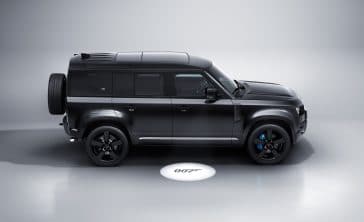Model Review
If you like cars, then you know the Land Rover Defender and what it represents for off-roading. Derived from the original Land Rover – the Series I – the Defender was originally named as such in 1983 and maintained many characteristics of that first version.
For the 1983 rebrand from the Series III, the Defender came in the shape of the 90 and the 110, which were later followed by the 127 and 130, showing the adaptability and variety of the model.
In 1990 the Defender was slightly remodelled for a new range of engines and only got minor updates through the 90s and 2000s. Coming in many body styles, including pick-ups and double-cabs, the Defender has earned a reputation of being great off-road and has even been used by the Armed Forces because it was so good.
But due to its poor safety and emissions rating, the Defender was officially retired in 2016 – which was greeted with much opposition for petrolheads – and the famous model is now only available as a used model. There are, however, concepts and prototypes for a reinvigorated and remodelled Defender in the works at Land Rover, so there is still life in the old dog yet.
Value for money
Surprisingly considering the model’s popularity and reputation, you would expect good levels of equipment and comfort. But the Defender was more commonly known for having limited accessories and being the simplest essence of off-roading.
So most of the models you will find on the used market will have been modified to suit the taste of the previous owner, including more comfortable seats and adventure packs to make it more practical and adaptable.
One example of one of the last models was a 2016 ’65 plate Defender 90 with the Adventure package added. With it comes electric front windows, under-body protection, permanent four-wheel drive, LED headlamps, power-assisted steering, DAB radio with CD player and AUX/Bluetooth connectivity, an access ladder and a roof rack, which offers more practical facets when off-roading. It comes with only 5,690 miles on the clock but due to its recent build and large amount of add-ons it costs £45,000.
Other used models that don’t have additions and have been used thoroughly are also available, but many of those have high mileage and can be difficult to maintain. But it is seen that the main reason you buy a Defender is not for accessories and whether they are comfortable or not – it’s the image that the iconic vehicle holds and if it can be a good project to revamp and renovate, especially with older versions.
Looks and image
Although you can tell the difference between each generation of the Defender, the shape did not change too much over the model’s tenure and that is a good thing because there are few models that are as iconic as the Defender.
Even when it was updated in 2012 it kept its vintage look that has helped to make it so recognisable and even with it coming in a large range of body styles, the standard Defender look is kept throughout. The long bonnet, squared-off body and raised ride height is the quintessential off-roader and it has been the base template for many other 4x4s since.
In terms of driving the Defender has a split personality and that can turn people away very easily. Off-road, the Defender is almost perfect thanks to its impressive ground clearance, sturdy chassis and four-wheel drive with low range gearing and is still a benchmark for other SUVs to strive for.
Unfortunately, the same can’t be said for when it’s on the road. It is unwieldy, difficult to control and incredibly harsh in terms of suspension. The steering is overly weighty and doesn’t respond well to commands, with excessive body roll and an unsettled ride on pretty much all surfaces rounding out a poor on-road performance for the Defender.
With such a harsh ride setup and very spartan interior scope from base spec models, don’t expect to be in the lap of luxury when you’re driving or being taken somewhere in one. The driving position is cramped, adjustability is limited and, due to the harsh suspension, ride comfort is not great. But there is a high level of adaptability with what you can do behind the front seats. In the longer wheelbase models you can get as many as 11 people in the back – which can be very handy indeed – but not necessarily in supreme comfort.
Space and practicality
Depending on which wheelbase you choose the Defender can be very practical indeed. In the short wheelbase ’90’ versions the space is not as great as you would think as the back seats do take up a lot of space, but in longer wheelbase models and even pick-up version, you will find a good amount of storage space.
There isn’t one set figure for the Defender due to the adaptability and multiple variations on offer, but if you’re looking for practicality go for one with a longer body.
Here is an area that will worry prospective Defender buyers – safety. The Defender has never been officially examined by Euro NCAP, and with no airbags, seatbelt pretensioners or any safety systems of note, the Defender does struggle to be an overly secure car. The most recent models did come with traction control and ESC, but that doesn’t retract from the fact it suffers heavily in this department.
Families, therefore, may feel that the Defender is not the car for them, especially when models don’t come with Isofix fastening points as standard and the overall comfort of the model may also push them away.
Engines
The final model only came with one engine and gearbox combination – a 2.2-litre four-cylinder diesel engine and a six-speed manual – and it isn’t exactly what you’d call smooth either. It does offer plenty of torque so you can tow up to 3500kg and is good off tarmac, but it is sluggish to 60mph – a yawn inducing 15.8 seconds – and a top speed of only 90mph. Most things on the road will outpace it, but with the low range gearbox ability few can match this engine/transmission combo off it.
Running costs
What eventually killed the Defender was its inefficient setup and almost astronomical running costs. With its mpg failing to break 30 at any point in its recent history and with emissions close to 300g/km CO2, Land Rover were unable to adapt the Defender to take more efficient units and the extensive running costs were the reason why it was finally cut. If you are willing to take that on-board, then nothing will dissuade you because the insurance bands put it into the groups in the mid-20s and due to the fact no new ones are on sale anymore, road tax is £140 per year.
Things to look out for
Due to the bare bones nature of the Defender it has performed well in terms of recalls and it wasn’t until the model was modernised did things start to cause minor issues. The main issue that came up was the model was involved with its brakes, whether that be with its parking brake or with it suffering an imbalance. Reliability-wise, the Defender did suffer on occasion from minor issues, but due to the relative simplicity of its structure, the Defender is simple to fix.
Rivals
Due to their similar layout and structure, only the Jeep Wrangler and Mercedes G-Class can be classed in a similar sort of bracket. Few common SUVs can match the Defender’s off-roading capabilities but are much more usable on a day-to-day basis, so it is difficult to compare it to any modern model.




